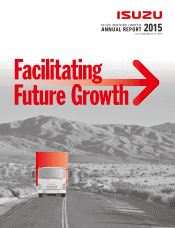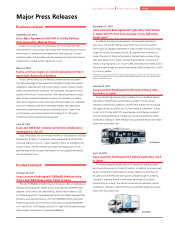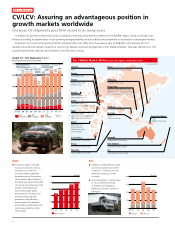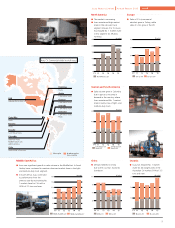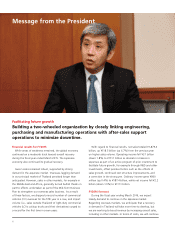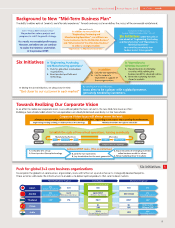Isuzu 2015 Annual Report Download - page 8
Download and view the complete annual report
Please find page 8 of the 2015 Isuzu annual report below. You can navigate through the pages in the report by either clicking on the pages listed below, or by using the keyword search tool below to find specific information within the annual report.
6
Facilitating future growth
Building a two-wheeled organization by closely linking engineering,
purchasing and manufacturing operations with after-sales support
operations to minimize downtime.
Financial results for FY2015
While areas of weakness remained, the global economy
continued on a moderate track toward overall recovery
during the fiscal year ended March 2015. The Japanese
economy also continued its gradual recovery.
Isuzu’s sales remained robust, supported by strong
demand in the Japanese market. Overseas, lagging demand
in our principal market of Thailand persisted longer than
anticipated. However, sales in other markets, for example in
the Middle East and Africa, generally turned bullish thanks in
part to efforts undertaken as part of the Mid-Term Business
Plan to strengthen our overseas sales business. As a result
of these factors, we shipped a record number of commercial
vehicles (CV) overseas for the fifth year in a row, and import
volume (i.e., sales outside Thailand) of light-duty commercial
vehicles (LCVs: pickup trucks and their derivatives) surged to
a record for the first time in seven years.
With regard to financial results, net sales totaled ¥1,879.4
billion, up ¥118.5 billion (up 6.7%) from the previous year
on higher sales volume. Operating income fell ¥3.1 billion
(down 1.8%) to ¥171.1 billion as dramatic increases in
expenses as part of an active program of prior investment to
facilitate future growth, for example through R&D and other
investments, offset positive factors such as the effects of
sales growth, continued cost structure improvements, and
a correction in the strong yen. Ordinary income grew ¥800
million (up 0.4%) to ¥187.4 billion, while net income fell ¥2.2
billion (down 1.9%) to ¥117.1 billion.
FY2016 forecast
During the fiscal year ending March 2016, we expect
steady demand to continue in the Japanese market.
Regarding overseas markets, we anticipate that a recovery
in demand in Thailand will take more time to develop, but
we are working to boost revenue by increasing overall sales,
including in other markets. In terms of costs, we will continue
Message from the President

